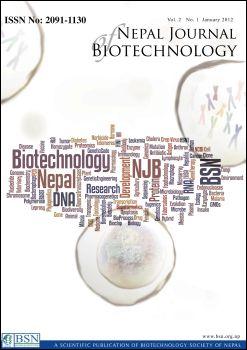Isolation and Characterization of Bacterial Endophytes from <i>Lycopersicon esculentum</i> Plant and their Plant Growth Promoting Characteristics
DOI:
https://doi.org/10.3126/njb.v2i1.5679Keywords:
Lycopersicon esculentum, endophytic bacteria, PGPR, IAA, 16SrDNAAbstract
The study was designed to isolate and characterize bacterial endophytes from root and stem of Lycopersicon esculentum plant which was collected form different region of Gujarat. Total 18 isolates of endophytic bacteria were selected in which, all the endophytic bacteria produced one or the other different characteristics involved in plant growth promotion. They either produced phytohormones like indole acetic acid, siderophore, protease, pectinase, organic acid showed antifungal activity, chromium tolerance and solubilized phosphate. Four of the strains among the 18 showed maximum positive results of plant growth promoting regulators (PGPR) test and among them best probable isolate was selected and thus its 16SrDNA was amplified and sequenced. Only HR7 endophyte of tomato turned out to be Pseudomonas aeruginosa. It’s a gram negative coccobacili, sporeforming motile bacilli and show maximum PGPR activity. The results of our present studies indicated that above strains might be endophytic and therefore, were associated with the plant growth.
Keywords: Lycopersicon esculentum; endophytic bacteria; PGPR; IAA; 16SrDNA
DOI: http://dx.doi.org/10.3126/njb.v2i1.5679
Nepal Journal of Biotechnology Jan.2012, Vol.2(1): 37-52
Downloads
Downloads
How to Cite
Issue
Section
License
Copyright Notice:
The manuscript submitted to NJB must be an original contribution, not previously published and should not be under consideration for publication elsewhere. When the manuscript is accepted for publication, the authors agree to automatically transfer the copyright of the article to the publisher. It should grant permission to any third party, in advance and in perpetuity, the right to use, reproduce or disseminate your article, according to the NJB copyright and license agreement.
Authors transfer copyright to the publisher as part of a journal publishing agreement but have the rights to: Share their article for Personal Use, Internal Institutional Use and Scholarly Sharing purposes, with the NJB applies the Creative Commons Attribution-NonCommercial CC BY-NC license to all the works we publish after Jun 2020 (Before it was CC BY-NC-ND). Under this license, authors agree to make articles legally available for reuse, without permission or fees, for virtually any non-commercial purpose. Anyone may remix, adapt, and build upon your work non-commercially, and although their new works must also acknowledge you and be non-commercial, they don’t have to license their derivative works on the same terms. More details on CC BY-NC refer to its Licence Deed and Legal Code.






